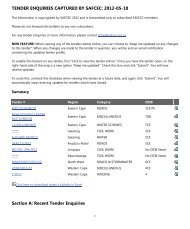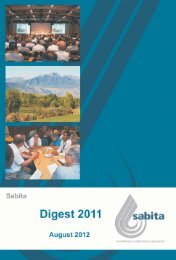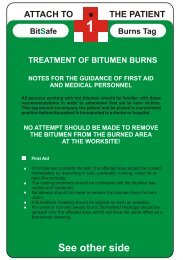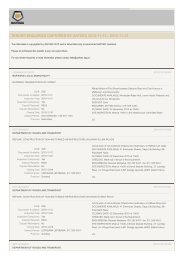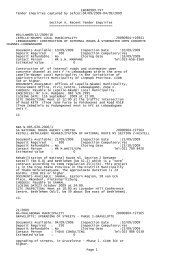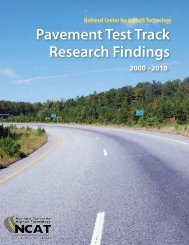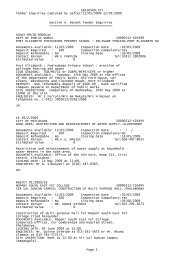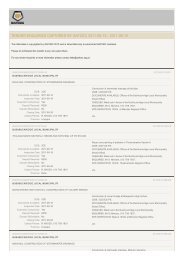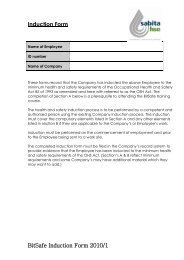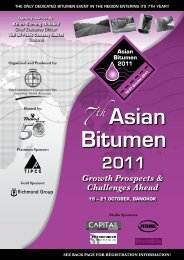DIGEST 2006 - Sabita
DIGEST 2006 - Sabita
DIGEST 2006 - Sabita
You also want an ePaper? Increase the reach of your titles
YUMPU automatically turns print PDFs into web optimized ePapers that Google loves.
The publication, Interim Guidelines<br />
for the Design of Hot Mix Asphalt<br />
in South Africa (prepared in 2001<br />
as part of the Hot Mix Asphalt<br />
Design Project launched in 2001<br />
by SANRAL, the CSIR and <strong>Sabita</strong>),<br />
supports this. A few extracts are:<br />
• Clause 2-16: Current<br />
specifications limit the<br />
maximum aggregate size to<br />
not more than half the<br />
compacted mat thickness.<br />
Designers should consider<br />
decreasing this limit;<br />
whenever conditions are<br />
anticipated in which<br />
compactibility or segregation<br />
might pose problems during<br />
construction;<br />
• Clause 2-18: Selection of<br />
maximum size aggregate i.e.<br />
9.5mm for 25mm thick mats;<br />
• Clause 4-8: Minimum voids in<br />
the mix for light traffic is<br />
3.5%.<br />
Impermeability<br />
What should be the main purpose<br />
of such a thin layer on low quality<br />
base in a heavy winter rainfall<br />
area?<br />
Impermeability for a start!<br />
Impermeability and good<br />
compaction go hand in hand. We<br />
don't want to pave thicker do we,<br />
that would be too much of a break<br />
in tradition. But we can easily<br />
design for higher density and low<br />
permeability.<br />
Design the mix for quick, easy<br />
compaction – remember the very<br />
short compaction window time.<br />
• Use a small maximum size<br />
aggregate;<br />
• Use a high bitumen content<br />
to provide good lubrication<br />
for compaction;<br />
• Target a low voids in the mix<br />
– light traffic will only<br />
marginally increase the<br />
construction density, so there<br />
is no risk of rutting or<br />
bleeding.<br />
What were the origins of this<br />
stubborn, ingrained tradition? Bob<br />
Kingdon tells a fascinating story.<br />
The construction of the freeway<br />
system in Cape Town in the 60's<br />
prompted the establishment of<br />
three production HMA plants. As<br />
freeway projects tailed off, the<br />
producers looked for alternative<br />
markets to keep their plants busy.<br />
Cracked windscreens<br />
In addition, the standard surfacing<br />
for residential roads then was a<br />
single seal. To allow immediate<br />
opening to traffic, chips were<br />
spread at a rate 1.2 times higher<br />
than was called for by the design.<br />
Result was a period of flying chips<br />
and cracked windscreens until the<br />
team came back to sweep up the<br />
excess.<br />
So the authorities were looking for<br />
an alternative, especially for the<br />
then emerging Michells Plain.<br />
The wearing course for the<br />
freeways had been approved and<br />
established – 40mm thick,<br />
13.2mm maximum size aggregate<br />
CCC mix.<br />
So just reduce the thickness to<br />
20mm to make it economical<br />
enough to compete with the single<br />
122



